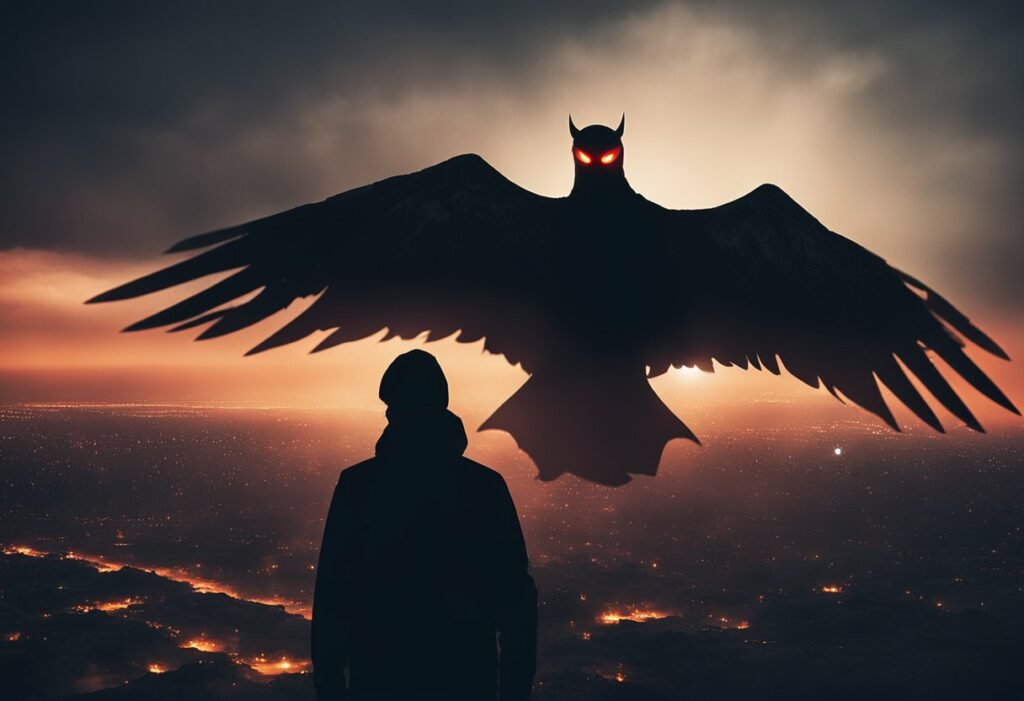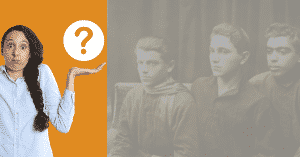As the Mothman legend evolved, so did its cultural significance, leaving an indelible mark on Point Pleasant and beyond. From purported connections to the tragic collapse of the Silver Bridge to sightings in places far outside of its supposed homeland, the Mothman narrative extends its reach. The proliferation of personal accounts, coupled with media portrayals and literature, has not only fueled the folklore but has also invoked scientific and skeptical inquiry into the phenomenon. The Mothman’s story isn’t just an isolated myth; it’s a vibrant chapter in the broader narrative of American mythology and its enduring fascination with the unexplained.
Key Takeaways
- The Mothman is a central figure in American urban legends, originating from Point Pleasant, West Virginia.
- Cultural impact and continued interest in the Mothman highlights the interplay between mythology and community identity.
- Scientific skepticism and personal accounts contribute to a complex, ongoing discourse surrounding this elusive cryptid.
Origins of the Mothman Legend
The Mothman legend originates from a series of eerie encounters in the town of Point Pleasant, West Virginia, capturing popular imagination with its blend of real-world events and supernatural speculation.
Initial Sightings
On November 15, 1966, two young couples reported the first of many sightings of a large black creature with glowing red eyes near the site of a former World War II munitions plant, an area known locally as “the TNT area.” This encounter marked the beginning of the Mothman legend, stirring fear and curiosity throughout Point Pleasant.
The Mothman Prophecies
The Mothman was propelled into the realm of paranormal phenomena by John Keel’s 1975 book, “The Mothman Prophecies,” which connected the creature to various premonitions, including the tragic collapse of the Silver Bridge. The book cast the Mothman as an omen of impending disaster, intertwining mystery with folkloric roots.
Folkloric Roots
Mothman’s story is deeply ingrained in the lore of Point Pleasant and American folklore at large. Speculations about its origins range from a misunderstood local wildlife to a supernatural entity. It has become part of regional myth and legend, continually evolving with each retelling over generations, and cementing itself in the cultural history of the area.
Anatomy of a Cryptid
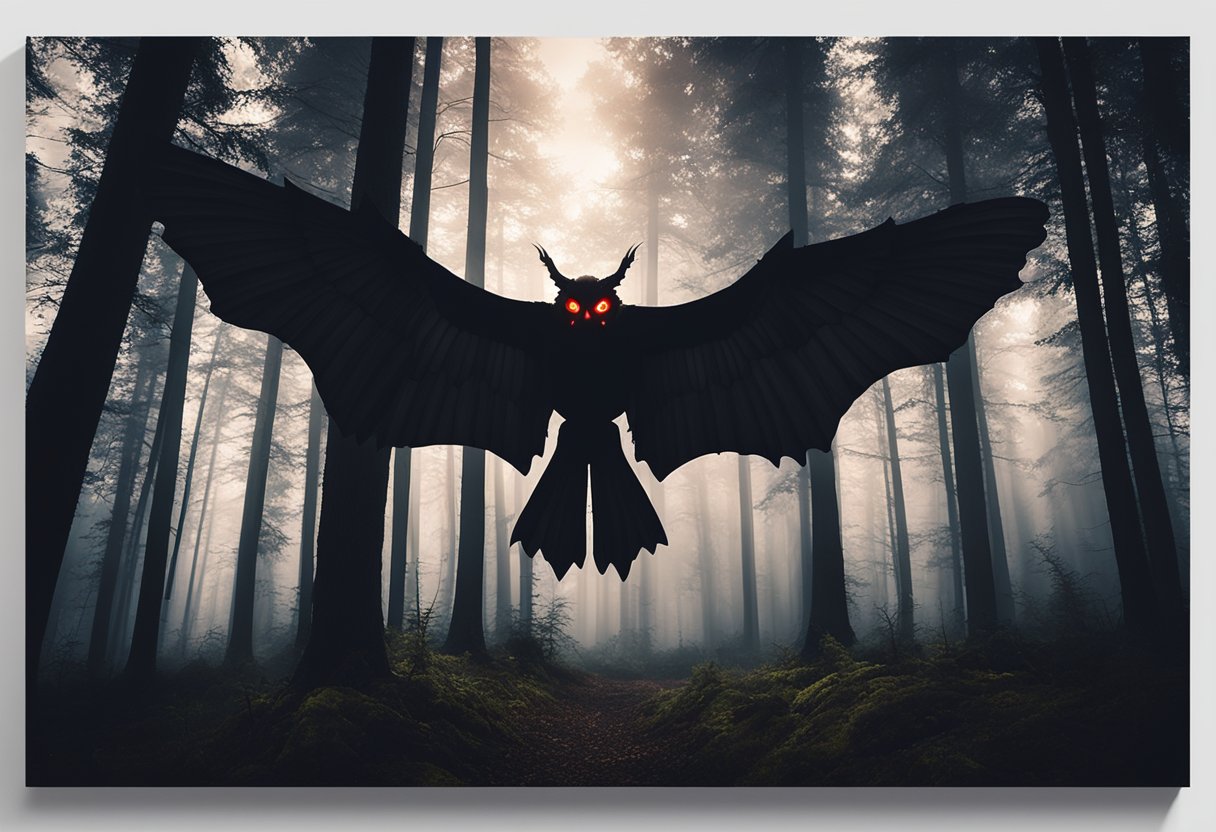
In exploring cryptids, their physical characteristics and possible origins offer intriguing insights. This section delves into the Mothman’s attributes and the theories behind this urban legend.
Physical Description
Mothman is often described as a humanoid figure with notable features. Consistent accounts mention:
- Wings: Large and possibly bat-like, these appendages are said to grant the creature the ability to soar.
- Red Eyes: Glowing and intense, adding an eerie aspect to sightings.
- Size: Reports typically describe a large presence, standing man-sized or larger.
Accounts of the Mothman vary, but the most frequent description is that of an imposing, winged creature with luminescent red eyes, akin to a human-bat hybrid. The consistency of these descriptions over time has contributed to the legend’s staying power, although some believe sightings may have been misidentified instances of naturally occurring species.
Possible Explanations
Several theories have been proposed for the Mothman sightings:
- Misidentified Fauna: The sandhill crane, a large bird with a significant wingspan and reddish coloring around the eyes, is a frequently cited culprit for some Mothman reports.
- Psychological Phenomena: Mass hysteria or the heightened state of anxiety might account for collective misinterpretations of both mundane and unusual sights.
- Folklore and Hoaxes: Some suggest the stories have perpetuated due to hoaxes or as an evolving part of regional folklore in Point Pleasant, West Virginia.
While the enigma of the Mothman pervades popular culture, with many confident in what they report to have witnessed, experts typically attribute sightings to identifiable wildlife or social psychology phenomena.
Cultural Impact on Point Pleasant
Point Pleasant, West Virginia, has been profoundly shaped by the Mothman legend, especially through its prominent Mothman Statue and Festival, which have become central to the community’s identity and economy.
Mothman Statue and Festival
In the heart of Point Pleasant stands a striking silver statue commemorating the Mothman, a figure that has intrigued both residents and visitors since the initial sighting in 1966. This statue not only serves as a year-round attraction but also heralds the Mothman Festival, an annual event drawing thousands of enthusiasts. The festival celebrates the cryptid’s lore with a range of activities including guest speakers, vendor displays, and themed events, reinforcing the town’s embrace of its mysterious heritage.
Economic and Social Influence
The Mothman Festival has a significant economic impact, injecting vitality into Point Pleasant’s local businesses and encouraging tourism. Hotels, restaurants, and shops benefit from the influx of visitors, while the festival itself fosters community cohesion, offering an opportunity for social engagement and shared pride in Point Pleasant’s unique place in American urban legends. This annual confluence of curiosity seekers and folklore aficionados reinforces the cultural and economic fabric of the town, securing the Mothman’s place not just in legend, but also in the real-world development of its host community.
Mothman and the Silver Bridge Collapse
The mysterious entity known as Mothman is indelibly linked to the Silver Bridge disaster of 1967, a tragedy that remains a significant event in the lore of American urban legends.
The Tragedy of December 15, 1967
The Silver Bridge collapse occurred on December 15, 1967, during rush-hour traffic, resulting in the deaths of 46 individuals when it plunged into the Ohio River. This catastrophic event not only marked one of the most poignant structural failures in the United States but also cemented the connection between the Mothman sightings and impending calamities.
Prior to the disaster, numerous sightings of Mothman—a creature described as a flying humanoid with red eyes—were reported in and around Point Pleasant, West Virginia. These accounts detailed encounters with a cryptid that became an omen of the ensuing tragedy. The collapse itself has been analyzed extensively, with investigations identifying the failure of a single eye-bar in a suspension chain as the likely technical cause, but for some, the warnings perceived in the Mothman sightings added a layer of mythos to the Silver Bridge disaster.
The association between Mothman sightings and the bridge’s failure has been the subject of various adaptations in popular culture and the topic of speculation and debate, intertwining the cryptid with the history of the Silver Bridge collapse. The combined legend and tragedy of the Mothman and Silver Bridge have left an enduring legacy on the lore surrounding cryptids and the interpretation of warnings and omens in the face of disasters.
Mothman Sightings Beyond West Virginia
While the notorious Mothman is rooted in the folklore of Point Pleasant, West Virginia, subsequent sightings of this enigmatic creature have been reported far beyond the state’s borders. Reports within the United States and from around the globe suggest that the legend of the Mothman has migrated along with the creature itself, prompting an array of encounters that intertwine with tales of UFO sightings and other unexplained phenomena.
Around the United States
In Ohio, close to West Virginia’s borders, there have been multiple accounts of Mothman sightings. One notable location is the town of Chillicothe, where residents have reported seeing a large, winged entity with glowing red eyes. Further north, in Chicago, a series of sightings in 2017 reignited public intrigue. Witnesses reported a flying humanoid around Lake Michigan, leading some to speculate about the possibility of a migration route for the creature.
Additionally, there’s been a wave of over 55 reported encounters in the Chicago area alone, aligning with theories that Mothman’s presence could correlate with impending tragedies or strange occurrences. Although connecting these sightings with actual events remains speculative, the sheer number of reports gives some credence to the existence of something unexplained within the region.
Worldwide Reports
Moving beyond American soil, worldwide reports of Mothman-like creatures have surfaced, suggesting this may not be an anomaly confined to rural West Virginia. In Mexico, for instance, witnesses claim to have seen a creature resembling the Mothman in the midst of UFO sightings, creating a tapestry of high strangity and reinforcing the cryptid’s universal appeal within the world of paranormal and unexplained phenomena.
Across the pond, in the United Kingdom, there have been sporadic reports of large, winged creatures with reddish eyes, contributing to the global narrative of the Mothman. These international accounts are often fragmented and vary widely in detail but they share the core elements of the Mothman mythos—large wings, ominous presence, and an aura of mystery that fuels endless speculation and interest.
The Role of Media and Literature
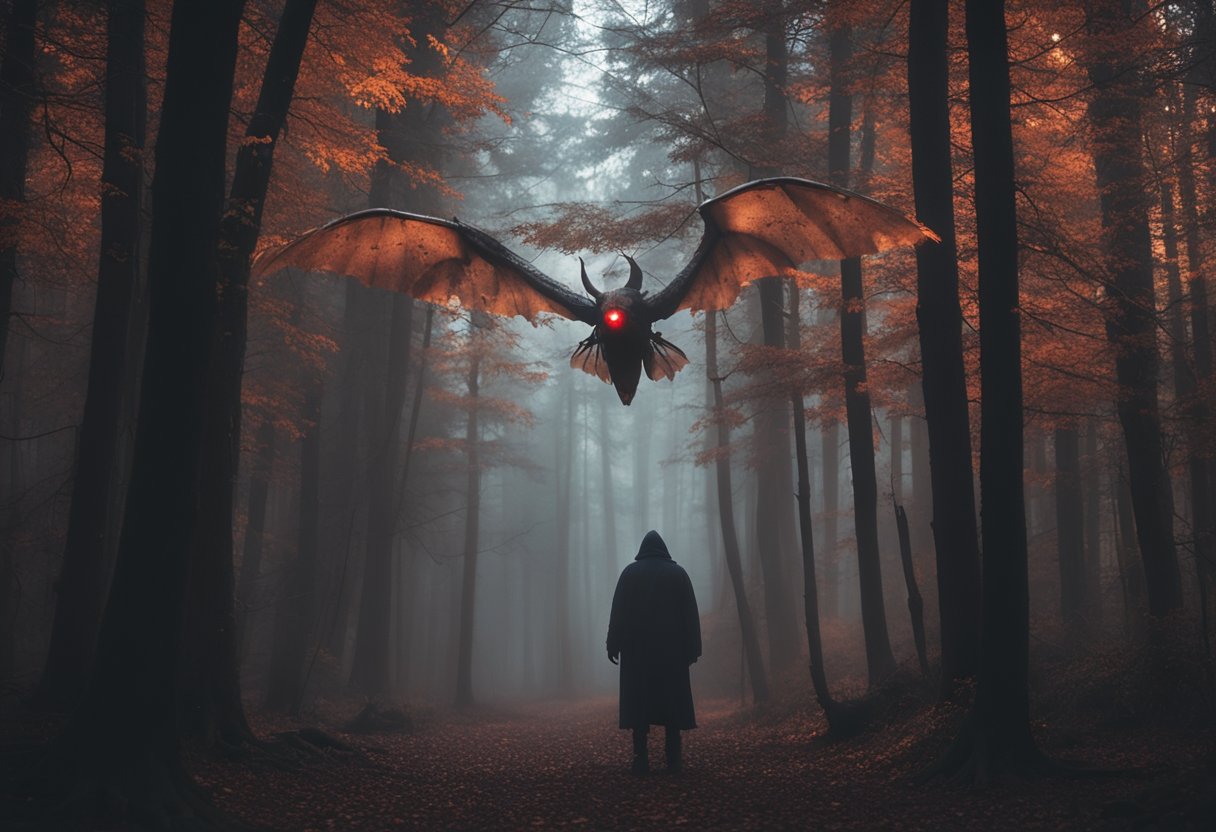
Media and literature have played instrumental roles in cementing the Mothman, among other cryptid myths, into the fabric of American urban legends. They serve both as a means of entertainment and as a source of documentation, feeding the public’s fascination and skepticism alike.
Books and Films
Books like John A. Keel’s “The Mothman Prophecies” have been pivotal in chronicling the eerie events associated with the Mothman in Point Pleasant, West Virginia. Keel’s work, which delves into the sightings and subsequent prophecies, created a narrative around the Mothman that transcends mere folklore.
Films, on the other hand, bring these stories to life with visceral imagery and dramatic portrayals, broadening their reach. The 2002 film adaptation of Keel’s book contributed greatly to the Mothman’s notoriety, using cinematic tools to amplify the legend’s mysterious and unsettling nature.
News Coverage and Documentation
The Point Pleasant Register was amongst the first to report sightings of the Mothman with their article titled “Couples See Man-Sized Bird … Creature … Something.” This initial news coverage sparked a flurry of interest and subsequent investigative reporting.
Documentation in media outlets, supported by establishments like the Mothman Museum, ensures the preservation and dissemination of Mothman-related phenomena, providing a collective memory of events for enthusiasts and skeptics to review and deliberate upon. The museum itself is a testament to the enduring impact media coverage has had on the Mothman legend.
Scientific and Skeptical Perspectives
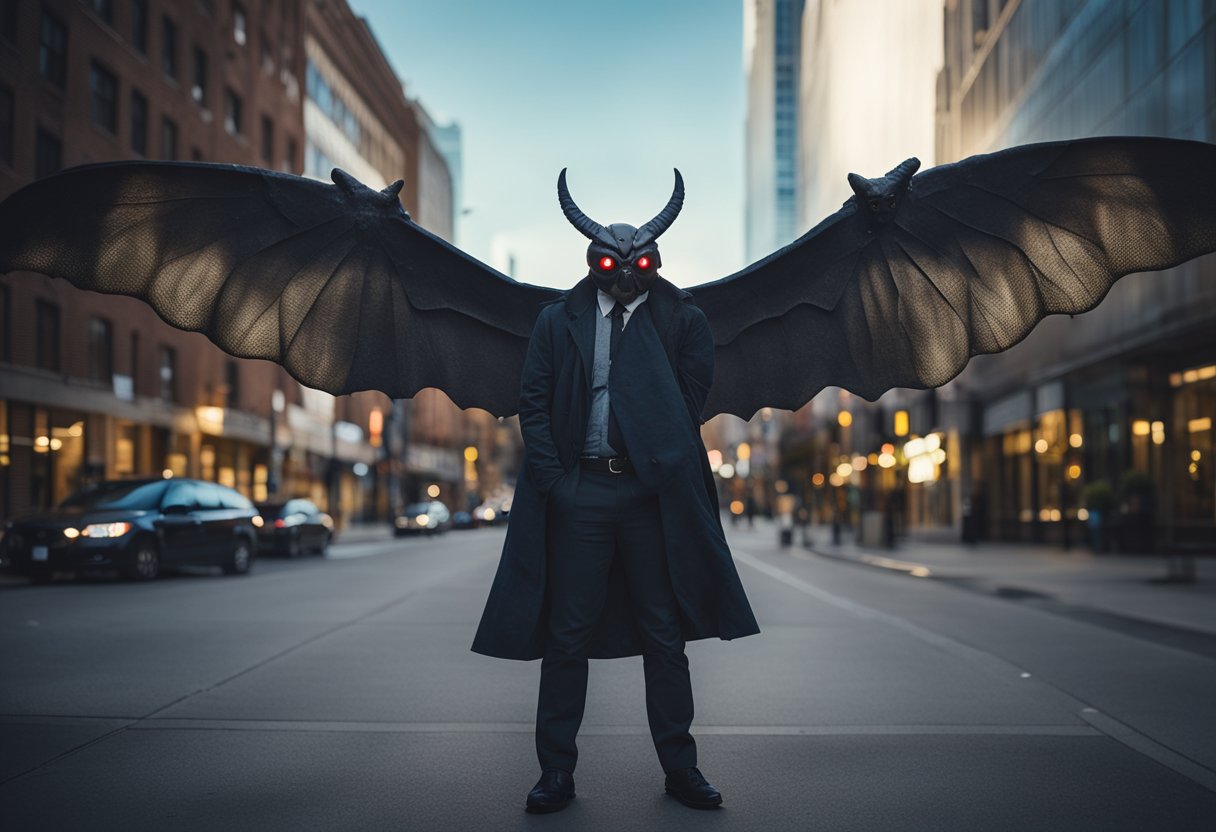
In addressing the Mothman legend, it’s essential to consider the scientific community’s view alongside that of professional skeptics. They approach these claims with stringent criteria for evidence, taking into account both zoological knowledge and psychological factors that may contribute to the propagation of such urban legends.
Cryptozoology and Zoology
Cryptozoologists investigate creatures like Mothman, whose existence is not recognized by conventional zoology. These entities are often termed “cryptids,” a classification for beings like Mothman that have been sighted but lack empirical evidence. In contrast, traditional zoologists require rigorous documentation for species recognition, something no Mothman sighting has provided. There is a tendency among professionals to consider sightings as potential misidentifications, pointing towards native animals, such as an owl, with its nocturnal nature and capacity for silent flight, which could be mistaken for something more sinister under low light conditions.
Psychological Explanations
Psychological factors also play a significant role in explaining cryptid sightings. A combination of infrasound, or low-frequency vibrations, which can cause discomfort and even hallucinations, paired with local folklore, can potentiate town-wide hallucinations. Folklorists and skeptics suggest that a form of mass hysteria could amplify the spread of the Mothman legend. Ufologists and enthusiasts may attribute the same sightings to extraterrestrial activity, but this remains far from the conventional scientific view, which seeks a logical and evidence-backed explanation for such phenomena.
Mythology in Modern America
The fabric of American folklore is rich with entities that capture the imagination and reflect cultural anxieties. From cryptic creatures lurking in remote areas to bizarre happenings in urban settings, the mythology of modern America is a complex web of the strange and unexplained.
Mothman’s Kin
Mothman, a winged entity with a storied history in West Virginia, is often grouped with other cryptids of American folklore, such as the Jersey Devil, rumored to inhabit the Pine Barrens of New Jersey, and the Flatwoods Monster, an entity that added to West Virginia’s reputation for otherworldly beings. These creatures share common threads of mystery and intrigue, often eluding clear explanation despite the efforts of cryptozoologists and enthusiasts.
- Jersey Devil: Often described as a hoofed creature with bat-like wings.
- Flatwoods Monster: Noted for its eerie appearance and mistaken identity theories.
Legends and Tourism
Urban legends and myths, like that of Mothman, have profound impacts on local communities, often spurring tourism and festivals. For example, Point Pleasant, West Virginia celebrates its cryptid with an annual Mothman Festival, which commemorates the legend and attracts visitors from far and wide. Similarly, alleged sightings of Bigfoot across various states have infused local folklore and drawn curious crowds seeking the elusive creature.
- Bigfoot: This cryptid inspired the founding of the Bigfoot Field Researchers Organization (BFRO).
- Annual events: Festivals dedicated to cryptids celebrate the intersection of lore and community.
Personal Accounts and Eyewitnesses
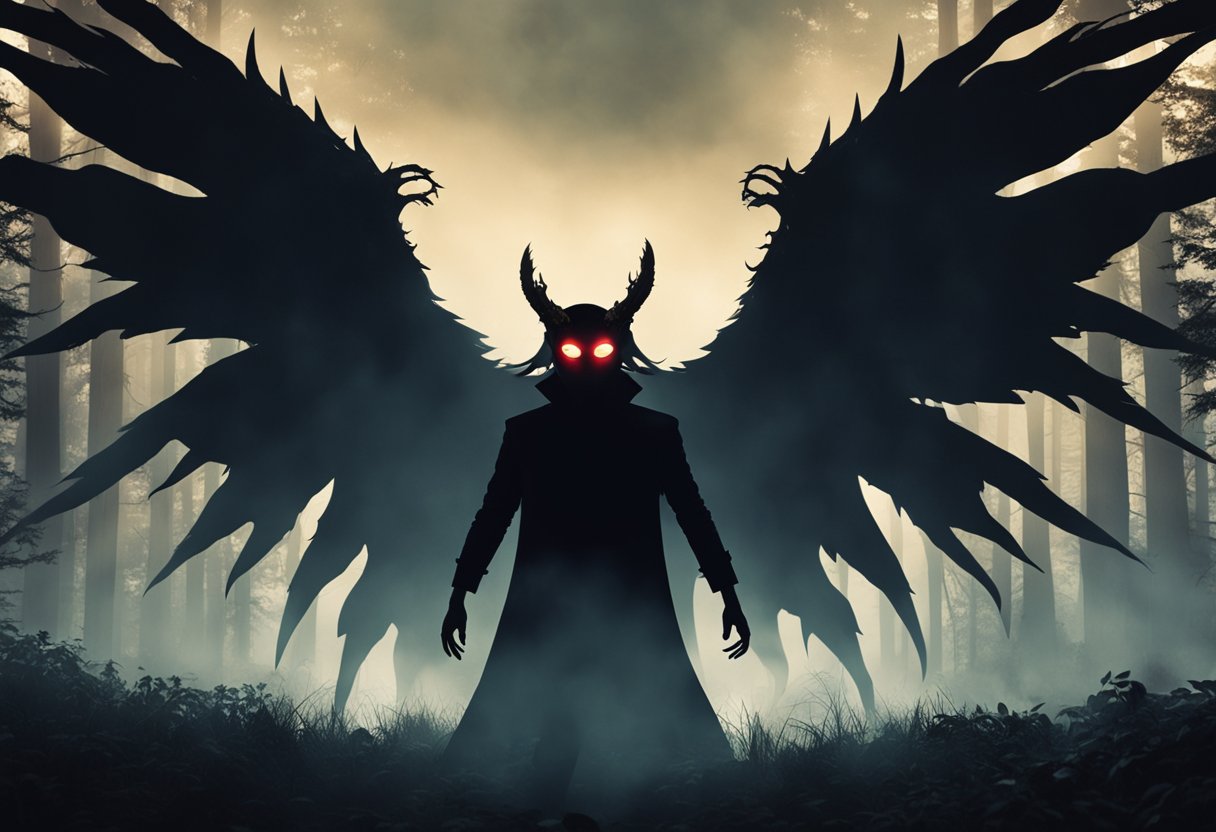
Personal accounts and eyewitness reports form the cornerstone of the Mothman legend, lending a human perspective to these mysterious sightings.
Credible Reports
Eyewitness accounts of the Mothman have varied, but several share common details—large, red eyes and a sizeable winged figure. Notably, Roger and Linda Scarberry along with Steve and Mary Mallette, two married couples, are often cited as credible witnesses. In November 1966, they reported seeing a large, gray creature with glowing eyes in the TNT area near Point Pleasant, West Virginia. Police investigations following their account took the sighting seriously but yielded no concrete evidence.
High-Profile Cases
The Mothman phenomena became entwined with the tragic Silver Bridge collapse in December 1967, when a structure connecting Ohio and West Virginia fell, resulting in 46 fatalities. Eyewitnesses claimed to have seen the Mothman near the vicinity of the bridge shortly before the catastrophe. This association with a high-profile incident has amplified interest and scrutiny in the folklore surrounding the Mothman, locking it into the realm of American urban legends.
Exploring the Paranormal Angle
The Mothman phenomenon intertwines with aspects of the paranormal, including theories of supernatural origins and ties to extraterrestrial activity. In particular, these accounts often feature chilling details such as glowing red eyes and mysterious UFO sightings.
Supernatural and Extraterrestrial Theories
Theories about the Mothman verge into the supernatural, suggesting more than mere earthly origins for this cryptid legend. Some assert that the creature exhibits paranormal capabilities, like precognition, and may be a harbinger of doom. During the Mothman’s most notable appearances in Point Pleasant, West Virginia, there was a surge in reports of UFOs and the eerie presence of Men in Black, suggesting a possible extraterrestrial connection.
Paranormal Research
Paranormal researchers have keenly investigated the Mothman legend, aiming to understand whether it is a supernatural entity or a misunderstood earthly creature. Despite numerous eyewitness accounts, concrete evidence remains elusive, and much of the research relies on piecing together anecdotal experiences and historical correlations, such as the tragic Silver Bridge collapse linked to Mothman sightings.
Frequently Asked Questions
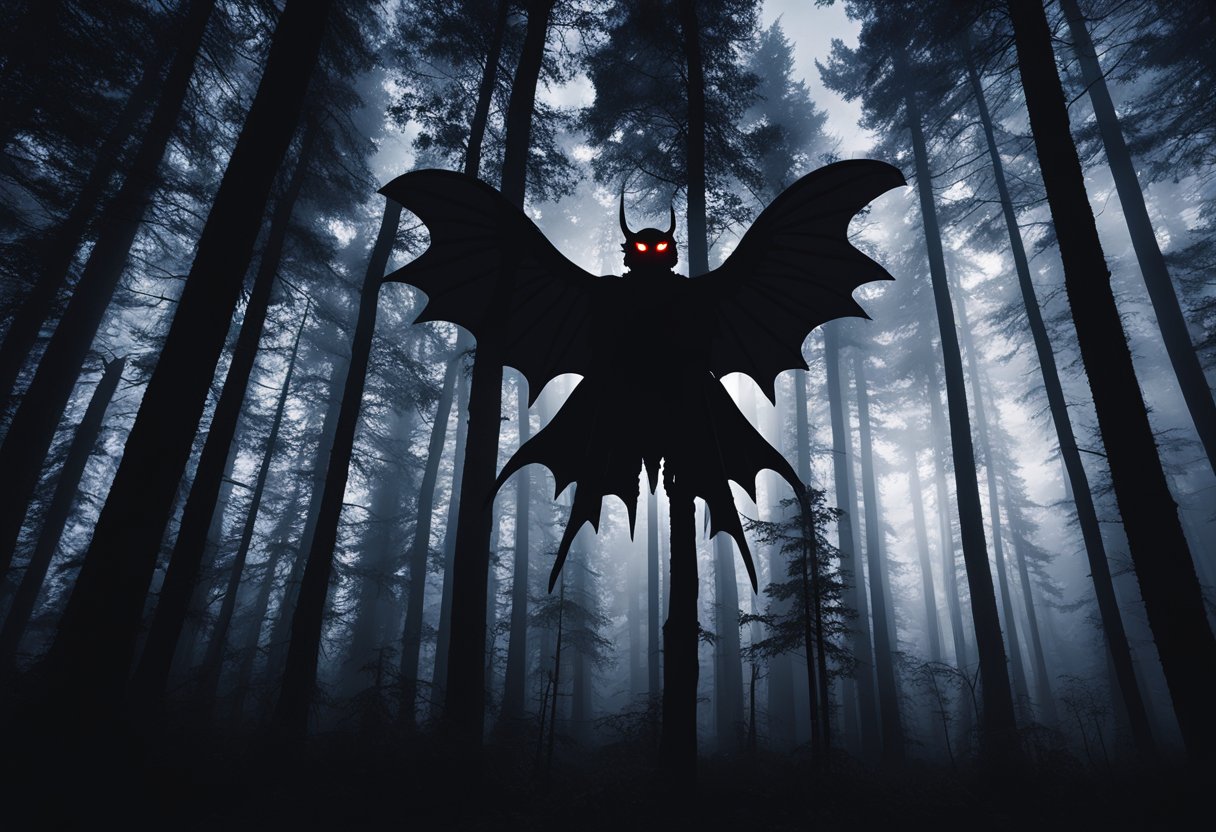
The Mothman legend is rich with intrigue and has sparked numerous accounts and theories. This FAQ section addresses some of the most common inquiries surrounding the Mothman mythos.
What is the origin of the Mothman legend?
The Mothman legend began in Point Pleasant, West Virginia, in 1966, with several sightings of a large, winged creature with glowing red eyes.
Are there any credible witnesses to the Mothman sightings?
Among the first to report a sighting were two young couples in Point Pleasant who described a large black creature with red glowing eyes near a former WWII munitions plant.
How has the Mothman myth influenced American culture?
The Mothman has become a fixture in paranormal lore, influencing American culture with books, documentaries, and an annual festival in Point Pleasant dedicated to the cryptid.
What are some common characteristics attributed to Mothman in various reports?
Typical characteristics include a large size, wingspan, and the distinctive feature of glowing red eyes reported by numerous witnesses over the years.
Can the Mothman sightings be linked to any known animals or natural phenomena?
While some theories propose that the Mothman sightings could be attributable to mass hallucinations or misidentified wildlife, a definitive explanation remains elusive.
What other cryptids are often mentioned alongside Mothman in American urban legends?
Alongside Mothman, other cryptids like Bigfoot and the Jersey Devil frequently feature in American urban legends, contributing to the broader cryptid mythology.

